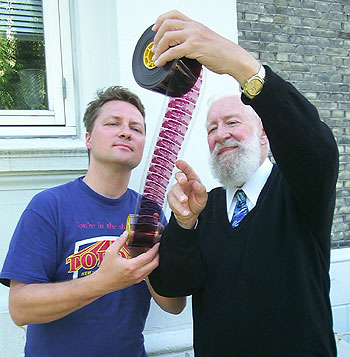Review of
Walter Siegmund interview
|
Read more
at in70mm.com The 70mm Newsletter |
| Written by: Grant Lobban, Film Historian, England | Date: 6 March 2005 |
 Walter
Siegmund (right) and Thomas Hauerslev, 22 June 2002 "examining" 70mm film
for the camera. Photo by Charlotte Hauerslev. Walter
Siegmund (right) and Thomas Hauerslev, 22 June 2002 "examining" 70mm film
for the camera. Photo by Charlotte Hauerslev.Following his previous interviews with other leading figures from the history of widescreen motion pictures, Thomas Hauerslev has now talked to Walter Siegmund. Walter acknowledged that Thomas´ infectious enthusiasm and skill at asking the right questions helped him to remember the time 50 years ago when at the American optical Company he joined the team assembled by Dr. Brian O’Brien to create the Todd-AO process. His fascinating story included being present at the first meeting with Mike Todd at which Dr. O’Brien agreed to bring his conception of "Cinerama out of one hole" to the big curved screen. It was then surprising to learn that although Walter had experienced Cinerama and thought it was a "'wow", Dr. O’Brien never went to see it for himself before the task began. If he had, he may have more fully appreciated the difficulties involved. If Cinerama’s inventor Fred Waller had been able to fill his large deeply curved screen with its very wide angle image using only one film and a single projector, he would surely have found a way to do it during the ten years it took to develop, rather than still ending up having to use the cumbersome triple-lens system. Also, like Walter, his team of optical scientists had little or no practical experience of motion picture engineering which may have discouraged them from taking some of the routes chosen to solve many of the problems. The prime example was all the time and effort lost trying to perfect the distortion-correction system designed to counter balance the effect on the image when having to project it onto a deeply curved screen at a steep angle. However, the account of all this ultimately “wasted” work was a highlight of the story, with details revealed of the then "secret”, ingenious optical printer which bent the image on the print into a curious "arched" shape. Even Walter had to admit that, although fine in theory, this idea could only present a truly undistorted picture to a limited number of the audience seated in the right place in the auditorium. At the time, no one was brave enough to tell the boss that this method was a lost cause, and it would have been better to throw the 'corrected' print which was destined for the premiere of "Oklahoma!" into the river to avoid the Todd-AO process gaining its initial poor, reputation. The still noticeable distortion and other technical flaws were not only reported in the trade press, but also mentioned in some of the reviews of the film. Although this, and other early aspects of Todd-AO, like trying to manufacture a screen with varying directional characteristics across its width, which Walter worked on, but were ultimately abandoned, has left him with memories tinged with a sense of failure, he still enjoyed his period as a scientist caught up in the world of showbiz. Re recalled the many personalities he met and gave us more details of Dr. O’Brien’s other achievements before and after his association with Todd-AO. Fortunately, Mike Todd gave Todd-AO another chance, and after changing to a more conventional projection arrangement using a flatter screen, the now superb images went on to grace the Oscar winning "Around the World in 80 Days" and later received its own Academy Scientific and Technical Award. The basic specifications of Todd-AO were subsequently adopted as standard for the 5-perf. 65mm/70mm system and is still current today having outlived most of its rival film formats also introduced during the 1950s. Thomas's interviews are invaluable, as relying only on contemporary published material can not always tell the whole story. Even technical articles by the developers themselves may include a promotional element, with any possible disadvantages glossed over to help sell a particular new screen process to the industry. Also, like Todd-AO, the original specifications may be changed in the light of experience gained during actual production and showing in theatres. If, like Walter Siegmund, there are other interesting 'widescreen' veterans out there, let's hope it´s Thomas who finds them to make sure that their stories reach us other big screen enthusiasts. |
Further
in 70mm reading: Walter P. Siegmund, a small bio Walter Siegmund Interview Todd-AO Hollywood Comes to American Optical Co. Internet link: |
More reviews of
Walter Siegmund interview
|
|
|
”I am very pleased with the interview. Its original research, really, and
it will be a great plus for the [in70mm.com] site when done”. Paul Rayton, chief projectionist Egyptian Theatre, Hollywood, USA “The interview with Walter is superb.” Brian O'Brien, Jr., CT, USA “This is a most informative interview, possibly the best, most lucid one I’ve ever read from anyone involved in any of the landmark widescreen systems”. Martin Hart, curator, widescreenmuseum.com, Texas, USA You have done a valuable piece of research. John Belton, Film historian, New York, USA It is an excellent interview Daniel J. Sherlock, film format historian, Brea, USA I enjoyed reading the Sigmund piece, it was very interesting and informative Dan Leimeter, chief projectionist Todd-AO (retired), Arizona, USA …it's terrific, a wealth of information Rick Mitchell, film historian, Los Angeles, USA I have nearly read the Siegmund intereview - on trains into work. It is long and complicated. However, it is excellent. Bill Lawrence, Head of Cinema, NMPFT, Bradford, England |
|
| Go: back
- top -
back issues
- news index Updated 28-07-24 |
|
